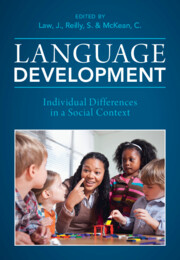Book contents
- Language Development
- Language Development
- Copyright page
- Contents
- Figures
- Tables
- Contributors
- A Tribute to Our Friend, Colleague and Fellow Editor, Professor James Law
- Introduction
- Part One Factors Influencing Language Development
- 3 Genetic Studies of Language Disorders
- 4 Hearing and Language
- 5 Co-occurrence between Language Disorders and Common Conditions in Childhood
- 6 Language and Cognition
- 7 Growing Up in Multilingual Communities
- 8 Parent–Child Interaction and Its Impact on Language Development
- 9 Cognitive Competencies and Signals of Risk
- 10 Creating Equitable Opportunities for Language and Literacy Development in Childhood and Adolescence
- Part Two Continuity and Change
- Part Three Impact, Intervention and Equity
- Index
- References
10 - Creating Equitable Opportunities for Language and Literacy Development in Childhood and Adolescence
from Part One - Factors Influencing Language Development
Published online by Cambridge University Press: 11 August 2022
- Language Development
- Language Development
- Copyright page
- Contents
- Figures
- Tables
- Contributors
- A Tribute to Our Friend, Colleague and Fellow Editor, Professor James Law
- Introduction
- Part One Factors Influencing Language Development
- 3 Genetic Studies of Language Disorders
- 4 Hearing and Language
- 5 Co-occurrence between Language Disorders and Common Conditions in Childhood
- 6 Language and Cognition
- 7 Growing Up in Multilingual Communities
- 8 Parent–Child Interaction and Its Impact on Language Development
- 9 Cognitive Competencies and Signals of Risk
- 10 Creating Equitable Opportunities for Language and Literacy Development in Childhood and Adolescence
- Part Two Continuity and Change
- Part Three Impact, Intervention and Equity
- Index
- References
Summary
Language is one of the most remarkable developmental accomplishments of childhood and a tool for life. Over the course of childhood and adolescence, language and literacy develop in dynamic complementarity, shaped by children’s developmental circumstances. Children’s developmental circumstances include characteristics of the child, their parents, family, communities and schools, and the social and cultural contexts in which they grow up. This chapter uses data collected in Growing up in Australia: The Longitudinal Study of Australian Children (LSAC) that was linked to Australia’s National Assessment of Literacy and Numeracy (NAPLAN) to quantify the effects of multiple risk factors on children’s language and literacy development. Latent class analysis and growth curve modelling are used to identify children’s developmental circumstances (i.e. risk profiles) and quantify the effects of different clusters of risk factors on children’s receptive vocabulary growth and reading achievement from age 4 to 15. The developmental circumstances that gave rise to stark inequalities in language and literacy comprise distinct clustering of sociodemographic, cognitive and non-cognitive risk factors. The results point to the need for cross-cutting social, health and education policies and coordinated multi-agency interventions efforts to address social determinants and break the cycle of developmental disadvantage.
Keywords
- Type
- Chapter
- Information
- Language DevelopmentIndividual Differences in a Social Context, pp. 231 - 256Publisher: Cambridge University PressPrint publication year: 2022
References
- 2
- Cited by

